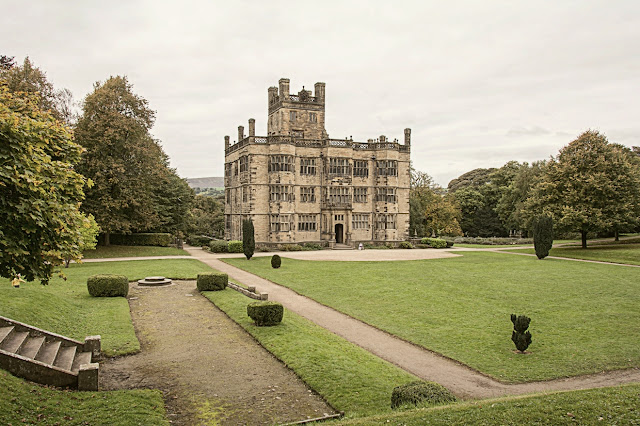Happy Birthday, Charlotte Brontë (1816-1855)!
"I am bound to you with a strong attachment.
I think you good, gifted, lovely:
a fervent, a solemn passion is conceived in my heart;
it leans to you, draws you to my centre and spring of life,
wraps my existence about you, and
kindling in pure, powerful flame,
fuses you and me in one."
Last year it was Charlotte Brontë's 200th birthday anniversary, and I marked the day by my own personal tribute to her. This year I thought I'd share some of my favourite photos I took last year in the Bronte Parsonage Museum, the home of the literary Brontë Sisters since their early childhood, where new displays and installations were set up in celebration of Charlotte's special year.
The dining room. The sisters wrote most of their stories, novels and poems at this table and also used to walk around it every evening reading and talking to each other about their writing plans. The table, one of the most important literary artefacts of the 19th century, was sold after the death of Mr Brontë (the siblings' father), and only recently acquired by the Brontë Society and brought back to its original home.
I love looking at the objects on this table, all original family belongings.....
Detail from Mr Brontë's study - his top hat and the piano he bought for his children.
Mr Brontë's study where he carried out most of his parish business (being a curate of Haworth church situated opposite the Parsonage). It is also the room where he first discovered that Charlotte, his eldest daughter, was a successful author following the publication of "Jane Eyre" that was to become her timeless, worldwide masterpiece.
The Kitchen. As children, the Brontës liked gathering around the fire to listen to their servant Tabby's dark tales of the Yorkshire moors. Mr Patrick Brontë's successor, the Reverend John Wade, made some alterations to the Parsonage, including the kitchen. The old range was removed in the process, and consequently, a kitchen range of the correct period was installed to help recreate the room's original appearance. The furniture and utensils are original - those that belonged to the Brontë family.
The sisters were expected to take their share of household chores. Emily, being the one who stayed at home the most, acted as housekeeper helping in the kitchen. She was particularly good at baking bread. Displayed in this photo is also her German dictionary; she liked to study German while carrying out her kitchen tasks.
Part of the beautiful, elegant hall with sandstone stairs, a wood banister and classic Georgian style window on the sill of which there is always a stunning seasonal flower arrangement. The walls are a lovely duck egg shade recreated to look like the original colour of the walls.
The mahogany longcase clock stands halfway up the stairs. Every night, around nine o'clock, Mr Brontë would lock the front door and then, stop on his way up to his bedroom to wind up the clock.
This is the cabinet in Charlotte's room where her dresses and accessories are always on display. The display changes every year, and this is what was chosen for Charlotte's bicentenary year.
The room was the main bedroom, initially used by Charlotte's parents, and then by different members of the family over the years, depending on who happened to be at home at any particular time. After the death of her sisters, Charlotte occupied this room alone. It is also the room she shared with her husband, and where she died.
Charlotte's room contains a selection of memorabilia associated with her, like this pair of mourning shoes. They were made of leather, silk and human hair. Long walks over rough ground caused damage to these fragile shoes which Charlotte poignantly repaired with the hair of her departed siblings.
This handkerchief, that was on show in one of the cabinets in Charlotte's room, bears her self-caricature which she originally drew in an illustrated letter from Brussels. Regarding herself as plain, she caricatured herself as an ugly, dwarf-like figure.
Charlotte and her sisters inspired many artists around the world, among them Tamara Stone from New York who created a miniature bed, embroidered all over with the literary siblings' words. It was displayed in the Children's Study - the tiny room they played and wrote in their hand-made "little books". The room later became Emily's bedroom.
Mr Brontë's Bedroom. After the untimely death of his wife, Patrick left the room they had shared and moved into this bedroom which remained his for the rest of his life. When his son Branwell's unfortunate addiction to alcohol and opium became danger both to himself and his family, Patrick shared his bedroom with his son in order to watch over him. Branwell died here, and many years later Patrick died in this room, too. Very little of the bedroom furniture survives; this half-tester bed is a reproduction based on a sketch made by Branwell.
Another inspired artwork. Denise Salway (aka The Knitting Witch) recreated a key scene from "Jane Eyre" in wool. I love seeing how the Brontës inspired people, being inspired by them in so many ways myself.
Brontë Parsonage Museum is currently engaged, for a second year running, in a five year programme of activity celebrating the Brontës' bicentenaries: Charlotte in 2016, Branwell in 2017, Emily in 2018, Anne in 2020; and in 2019 their father Patrick will be commemorated, too - it will have been 200 years of his taking up curacy in Haworth Church.
So this year marks troubled brother Branwell's bicentenary, and I am looking forward to putting together my best photos from around this year's Parsonage and sharing them at Branwell's birthday in June.


















I was really want to get some more detail and information about the Barbie Charlotte's Life but your blog helped me so much thank you for sharing it.
ReplyDeleteBarbie Charlotte's Life